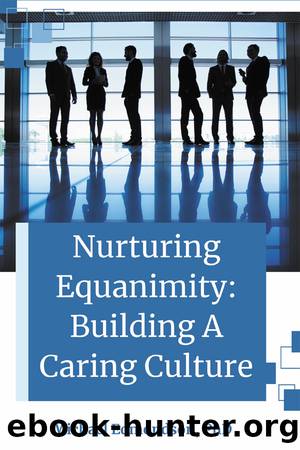Nurturing Equanimity by Michael Edmondson

Author:Michael Edmondson
Language: eng
Format: epub
Publisher: Business Expert Press
Published: 2023-07-13T00:00:00+00:00
âAs stress and burnout levels continue to climb amid the ongoing pandemic, employers are putting the overall well-being of their employees at the top of their list,â said Regina Ihrke, WTWâs senior director, health, and benefits. âThe organizations that most effectively move the needle are those that develop a comprehensive strategy that supports all aspects of their employeesâ well-being. Itâs also important to articulate that strategy to employees, conduct manager training and measure effectiveness.â17 As Kristin Lee wrote in Psychology Today, organizations need to âbake mental health support into work cultures.â To nurture equanimity and build a caring culture, baking mental health support into the employee experience means providing time paid time off, creating flexible work conditions, and treating people like actual human beings. âWork cultures that strive to avoid punitive and hierarchical ways, and instead work to build psychological safety and trust can breed the conditions that help mitigate burnout.â18 After helping leaders incorporate self-care into work cultures, Amy Jen Su echoed similar sentiment and observed âOne CEO I worked with summed it up best when he said: âSelf-care is no longer a luxury; itâs part of the job.ââ19
One model available to leaders and managers in those organizations who wish to nurture equanimity and create a caring culture by prioritizing self-care is the Substance Abuse and Mental Health Services Administrationâs (SAMHSA) Wellness Initiative. Since self-care and wellness is a broad concept, the SAMHSA provides individuals with a multidimensional approach for consideration that involves eight different elements: emotional, physical, occupational, intellectual, financial, social, environmental, and spiritual. âThese dimensions are interconnected, one dimension building on another.â20 By using this model, leaders and managers can prioritize self-care within a framework that covers eight different aspects of an individualâs life. Such comprehensive coverage of self-care demonstrates a high level of commitment the organization has toward its employees. For SAMHSA, âwellness is about how we live our lives and the joy and fulfillment and health we experience.â21 To help leaders and managers better understand the interconnectedness of these eight elements of self-care and wellness, here is an example to consider as the organization looks to nurture equanimity and create a caring culture.
When employees worry about money (most recently the escalating price of consumer goods outpacing pay raises), individuals may experience anxiety (emotional). With anxiety comes the possibility of related medical problems (physical) and even the potential for negative experiences at work (occupational). When this happens, the employee may start to question their sense of meaning and purpose (spiritual). Additionally, if an employee is laid off due to the financial collapse of their organization, and therefore, through no fault of their own, they stop working (occupational), lose opportunities to interact with others who they worked so closely with for years (social), and may not be able to afford the good food and medical care they need to stay well (physical). If the situation gets critical, the employee may even need to move out of their residence and into a more affordable place that feels less safe and secure (environmental).
Download
This site does not store any files on its server. We only index and link to content provided by other sites. Please contact the content providers to delete copyright contents if any and email us, we'll remove relevant links or contents immediately.
Tools of Titans by Timothy Ferriss(8308)
Change Your Questions, Change Your Life by Marilee Adams(7689)
Deep Work by Cal Newport(6969)
Playing to Win_ How Strategy Really Works by A.G. Lafley & Roger L. Martin(6090)
Man-made Catastrophes and Risk Information Concealment by Dmitry Chernov & Didier Sornette(5958)
Digital Minimalism by Cal Newport;(5707)
Big Magic: Creative Living Beyond Fear by Elizabeth Gilbert(5681)
The Slight Edge by Jeff Olson(5379)
Ego Is the Enemy by Ryan Holiday(5350)
The Motivation Myth by Jeff Haden(5176)
The Laws of Human Nature by Robert Greene(5087)
Stone's Rules by Roger Stone(5053)
Tuesdays with Morrie by Mitch Albom(4733)
Eat That Frog! by Brian Tracy(4484)
Rising Strong by Brene Brown(4414)
Skin in the Game by Nassim Nicholas Taleb(4206)
Bullshit Jobs by David Graeber(4143)
The Money Culture by Michael Lewis(4138)
Skin in the Game: Hidden Asymmetries in Daily Life by Nassim Nicholas Taleb(3962)
